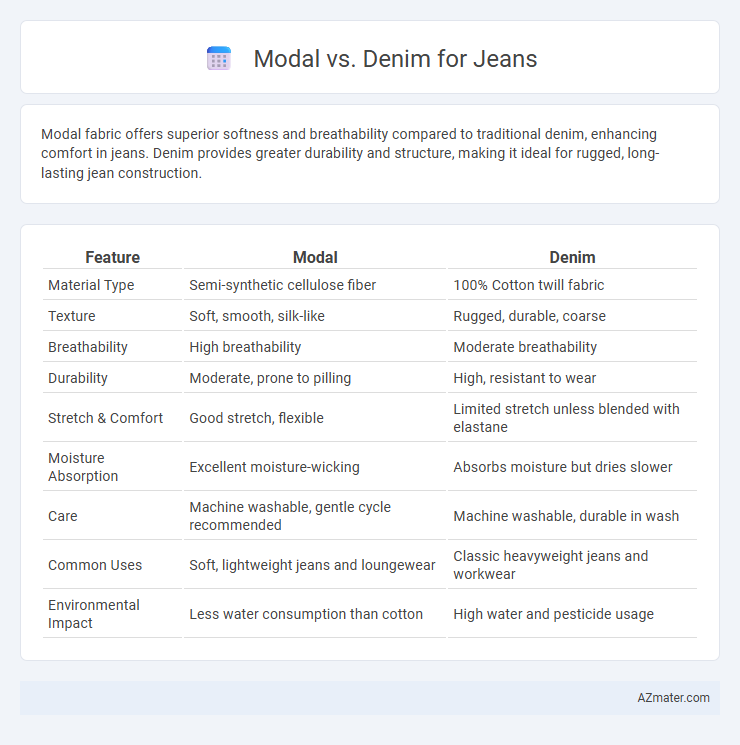Modal fabric offers superior softness and breathability compared to traditional denim, enhancing comfort in jeans. Denim provides greater durability and structure, making it ideal for rugged, long-lasting jean construction.
Table of Comparison
| Feature | Modal | Denim |
|---|---|---|
| Material Type | Semi-synthetic cellulose fiber | 100% Cotton twill fabric |
| Texture | Soft, smooth, silk-like | Rugged, durable, coarse |
| Breathability | High breathability | Moderate breathability |
| Durability | Moderate, prone to pilling | High, resistant to wear |
| Stretch & Comfort | Good stretch, flexible | Limited stretch unless blended with elastane |
| Moisture Absorption | Excellent moisture-wicking | Absorbs moisture but dries slower |
| Care | Machine washable, gentle cycle recommended | Machine washable, durable in wash |
| Common Uses | Soft, lightweight jeans and loungewear | Classic heavyweight jeans and workwear |
| Environmental Impact | Less water consumption than cotton | High water and pesticide usage |
Introduction to Modal and Denim Fabrics
Modal fabric, derived from beech tree pulp, offers exceptional softness, breathability, and moisture-wicking properties, making it a popular choice for comfortable, lightweight jeans. Denim, traditionally made from cotton twill, is known for its durability, rugged texture, and classic indigo dye, providing long-lasting wear and a distinctive look. Combining Modal with Denim enhances jean fabric by blending Modal's smoothness and stretch with Denim's sturdiness and structure.
Key Differences Between Modal and Denim
Modal fabric is a type of semi-synthetic cellulose fiber known for its softness, breathability, and moisture-wicking properties, making it ideal for comfortable, lightweight jeans. Denim is a sturdy, durable cotton twill fabric characterized by its rugged texture, thickness, and distinct diagonal ribbing, commonly used for traditional, long-lasting jean styles. The key difference lies in Modal's smooth, silky feel and stretchability versus Denim's robustness and classic denim appearance.
Fabric Composition and Origins
Modal fabric, derived from beech tree pulp through a semi-synthetic process, offers exceptional softness and breathability, making it a popular choice for blending with cotton in premium denim jeans. Denim, traditionally composed of 100% cotton woven in a twill pattern, originates from the French city of Nimes, where the name "denim" is derived ("de Nimes"). Combining modal with denim enhances flexibility and moisture-wicking properties, distinguishing modern hybrid jeans from classic all-cotton denim garments.
Comfort and Wearability Comparison
Modal fabric offers superior softness and breathability compared to traditional denim, enhancing overall comfort for extended wear. Denim, known for its durability and rugged texture, provides excellent support and structure but may feel stiffer and less flexible than modal blends. Combining modal with denim can improve wearability by balancing softness and strength, making jeans more comfortable without sacrificing durability.
Durability and Longevity
Denim is known for its exceptional durability and longevity due to its thick cotton twill weave, making it resistant to wear and tear over time. Modal, a semi-synthetic fiber derived from beech trees, offers a softer and more breathable alternative but tends to be less durable and may show signs of wear more quickly than traditional denim. For long-lasting jeans, denim remains the preferred choice, especially for heavy-duty use.
Environmental Impact and Sustainability
Modal fabric, derived from beech tree pulp, offers a more sustainable alternative to traditional denim by using renewable wood sources and less water-intensive production compared to cotton denim's heavy water and pesticide consumption. Denim manufacturing significantly contributes to environmental pollution through chemical dyes, large water usage, and soil degradation from cotton farming. Choosing modal jeans reduces the carbon footprint and conserves natural resources, supporting eco-friendly fashion with faster biodegradability and lower environmental impact.
Care and Maintenance Tips
Modal jeans require gentle washing in cold water and air drying to preserve fabric softness and reduce shrinkage, while avoiding bleach and high heat settings. Denim jeans benefit from turning inside out before washing to maintain color vibrancy and using mild detergents to prevent fading, with drying recommended on a low heat or line drying to avoid fiber damage. Both fabrics should avoid frequent washing to extend garment life and maintain their texture and durability.
Style and Aesthetic Appeal
Modal offers a smooth, silky texture with vibrant color retention, creating a sleek and polished aesthetic for jeans that appeals to contemporary fashion trends. Denim provides a rugged, textured appearance with natural fades and distressing, lending a classic, vintage vibe that enhances casual and streetwear styles. Both fabrics influence jean style significantly, with modal emphasizing elegance and softness, while denim underscores durability and timelessness.
Price Comparison: Modal Jeans vs. Denim Jeans
Modal jeans generally cost more than denim jeans because modal fabric is a semi-synthetic textile made from beech tree pulp, offering superior softness and breathability. Denim jeans, usually crafted from 100% cotton or a cotton blend, are widely available and produced in larger quantities, making them more affordable. The price difference reflects modal's eco-friendly production process and enhanced comfort qualities compared to traditional denim.
Choosing the Right Fabric for Your Jeans
Choosing the right fabric for your jeans hinges on understanding the key differences between modal and denim. Modal, a semi-synthetic fabric made from beech tree pulp, offers superior softness, breathability, and moisture-wicking properties, making it ideal for comfortable, lightweight jeans perfect for casual wear or warm climates. Denim, a sturdy cotton twill fabric known for its durability and classic rugged texture, suits jeans designed for longevity, heavy use, and the iconic structured appearance sought in traditional or workwear styles.

Infographic: Modal vs Denim for Jean
 azmater.com
azmater.com